Dateline 1994. The crude pile of pixels below from AT&T appeared on a website called “HotWired”.

About 44% of the people that saw it clicked.
The event is worth noting in the annals of advertising – the banner ad had arrived and a new era of digital marketing was born. 24 years, and billions of dollars later, the industry continues to evolve daily.
Today, it’s been said (far too often) you have a higher probability of surviving a plane crash or winning the lottery than clicking a banner ad.
Yes, this is a big slice of hyperbole, but it does open the gate to examining a very real problem in online marketing…
Banner ads are a bust.
You see, they’re subconsciously filtered out by almost everyone, a phenomenon that has come to be known as “banner blindness”.
Clickthrough rates are abysmal
Recent research from Smart Insights sheds some light on just how severe the problem is.
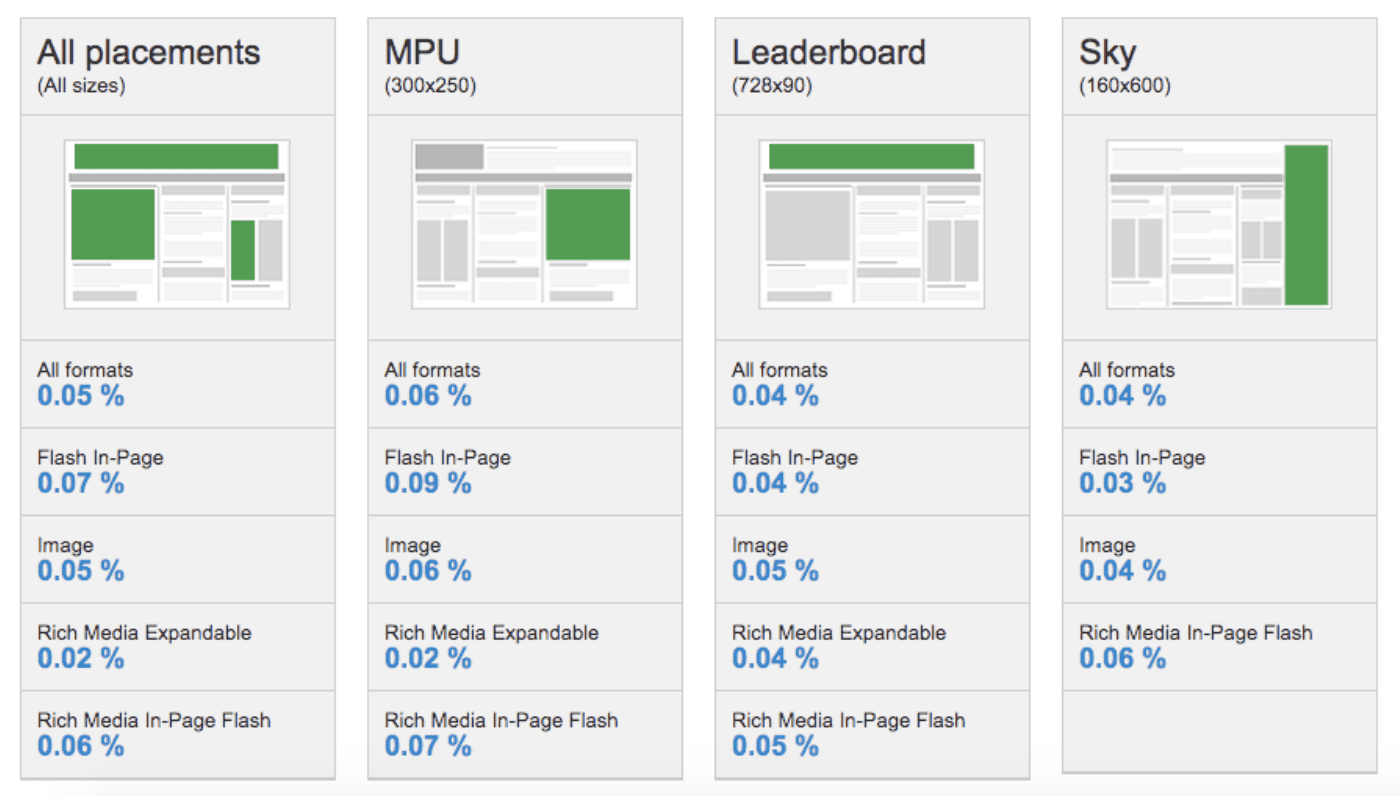
The research looked at various placements and sizes for display ads, and reported that the clickthrough rate (CTR) across all ad formats is 0.05%.
Ad clickthrough rate varies according to placement and format. The traditional “leaderboard” banner performs poorly compared to skyscrapers, the medium rectangle and the newer large rectangle format.
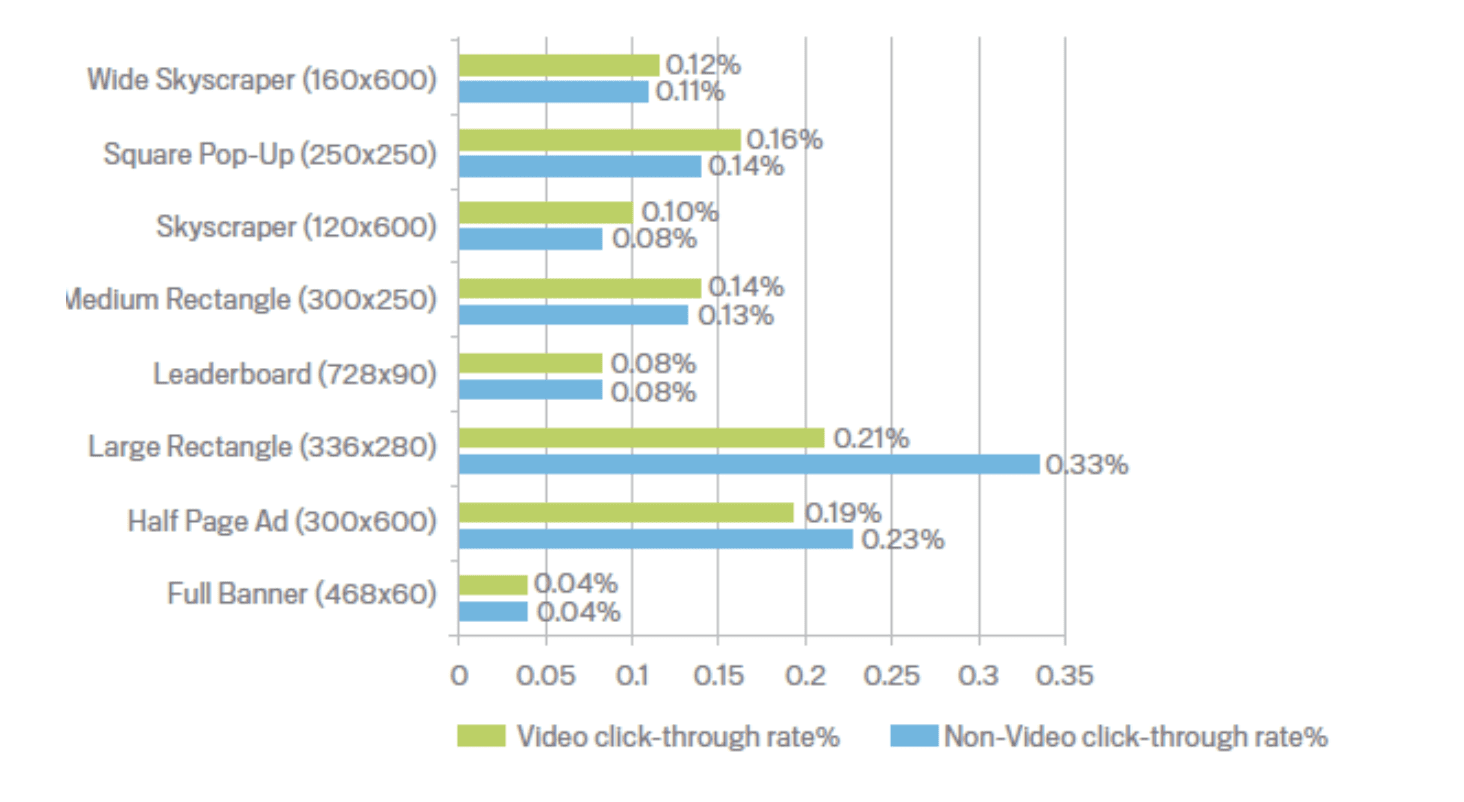
The study also claims that rich media ads realize a slightly better CTR of 0.1%. According to this research, CTR for video ads earn a slight advantage for some, but not all, formats.
The study claims CTR for other online ad formats – like Google AdWords and Facebook – can exceed 1%, and are more effective in that they typically have higher intent, and therefore see superior conversion rates.
Ad blocking is an issue
The growing popularity of ad blocking certainly adds to the woes of those who buy or sell display ads.
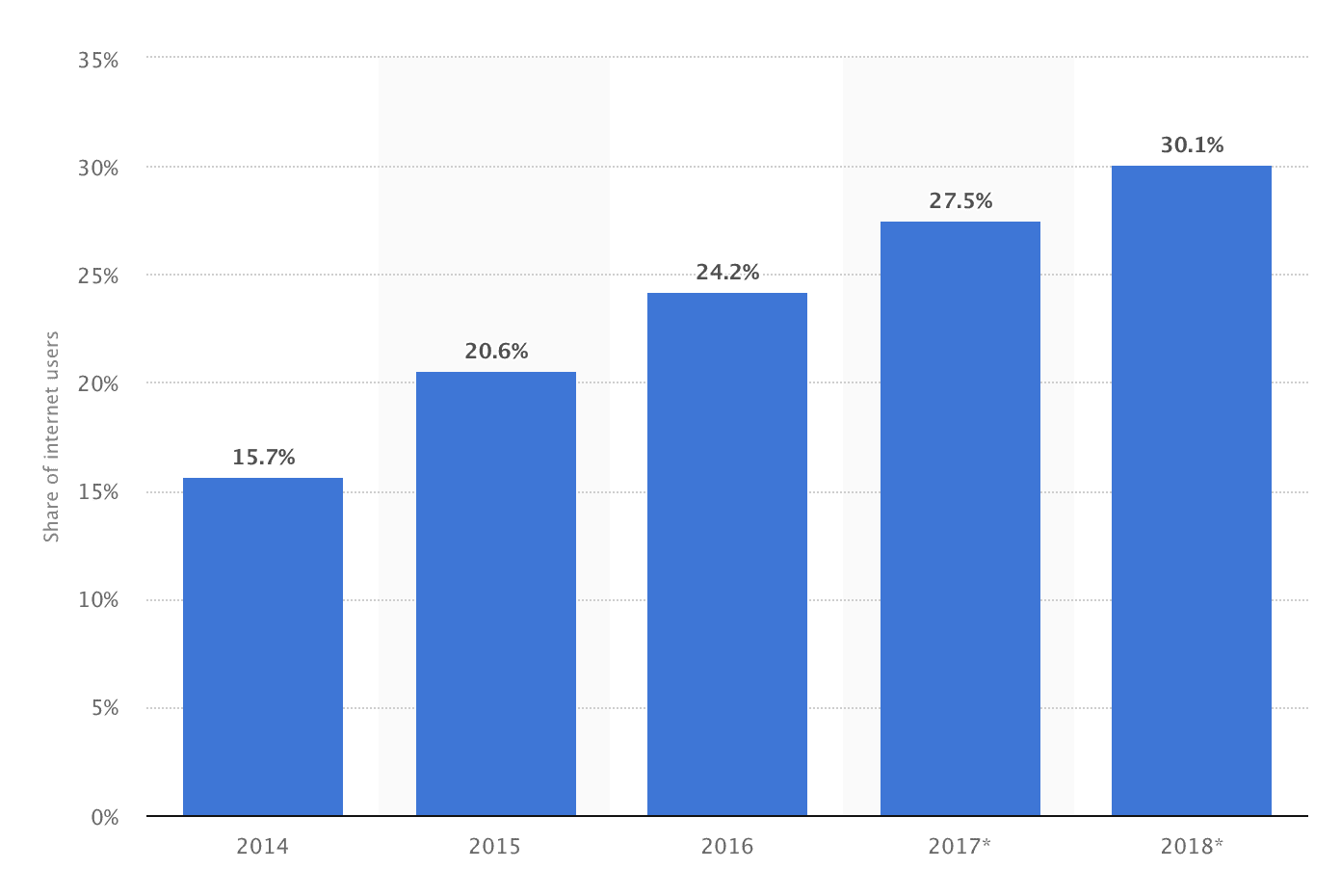
The above is data on ad blocking user penetration rate in the United States. In 2016, 24.4% of U.S. Internet users blocked ads on their connected devices (the 2017 and 2018 percentages here are projected).
Another sore spot related to ad blocking: the highest earners tend to be the most likely to install ad blocking software.
Advertisers, where are we now?
It seems clear banner ads don’t perform well. Should you be satisfied with .1% click-through rates and burning budget on impressions no one notices?
How do you respond to banner blindness?
Digital marketing expert Jeff Bullas offers suggestions:
- Place any type of ad strategically. Bullas recommends the use of ad placements in between blog posts.
- Buck the standards. Non-standard formats, unusual colors, and motion effects may help attract attention.
- Think mobile. Advertisers should optimize for mobile, use video, and include a “Call Now” button. Publishers should aim to reduce clutter.
Tips from Australia’s DigitalMonopoly agency include:
- Push your ads to the right audience. The post cites a study revealing only 2.8% of web users believed display ads they had seen were relevant to them.
- Analyze conversion, then target. Review the kind of traffic that is already converting for your site and target according to the demographics.
- Manage placements per perpetually. Once your campaign has been running for a while review the data to fine-tune your placements,
- Create better ads. Create ads that answer a specific question, offer a solution to a problem or invoke an emotion.
Their final recommendation introduces native advertising – and its central premise:
Make your ads look less like ads
Their post notes that:
“Native ads are often cited as the solution to banner blindness because they closely match the website on which they are displayed and therefore look as though they belong.”
The rest of this post is about native advertising, the antidote to banner blindness.

The “bottom line” in an Infolinks infographic reiterates some of the points covered thus far and says, “Go native.”
Insights from native advertising experts
As interest in traditional online advertising dries up, the content marketing revolution marches forth with growing momentum.
Native advertising provides the glue between content marketing and online advertising. It’s useful glue too. Brands use native advertising to combine their content marketing efforts with the expansive audiences reached via publisher sites. Ad blockers don’t factor in.
“Growth of native digital display is being driven by publishers’ pursuit of higher-value and more mobile-friendly inventory, as well as by advertisers’ demands for more engaging, less intrusive ads.”
“We’re seeing a huge ramp-up in non-social publishers adopting in-feed ads and video. Coupled with continued advances on the programmatic native front, this will accelerate non-social native display spending.”
– Lauren Fisher, eMarketing analyst
“Globally the predictions are that advertisers over the next four years will be moving 25% of their marketing budgets from traditional advertising to native advertising and content marketing.
This will represent the biggest structural shift since the emergence of TV-advertising.”
– Adam Abelin, Buzzanova (from Native Advertising Institute, 2018)
“Which part of the website gets the most engagement? It’s the editorial stream – the core content areas.
So the best place to deliver your ads is where you can natively embed them in your website’s content.”
– Neil Patel, Neil Patel Digital
“When you recognize the extreme saturation of search and social channels, native advertising becomes a more viable channel.
You simply use paid media to get content that feeds your funnel in front of people you otherwise wouldn’t reach. And understand, your reach isn’t an iffy proposition; it’s guaranteed.”
– Chad Pollitt, author of The Native Advertising Manifesto
Insights from native advertising research
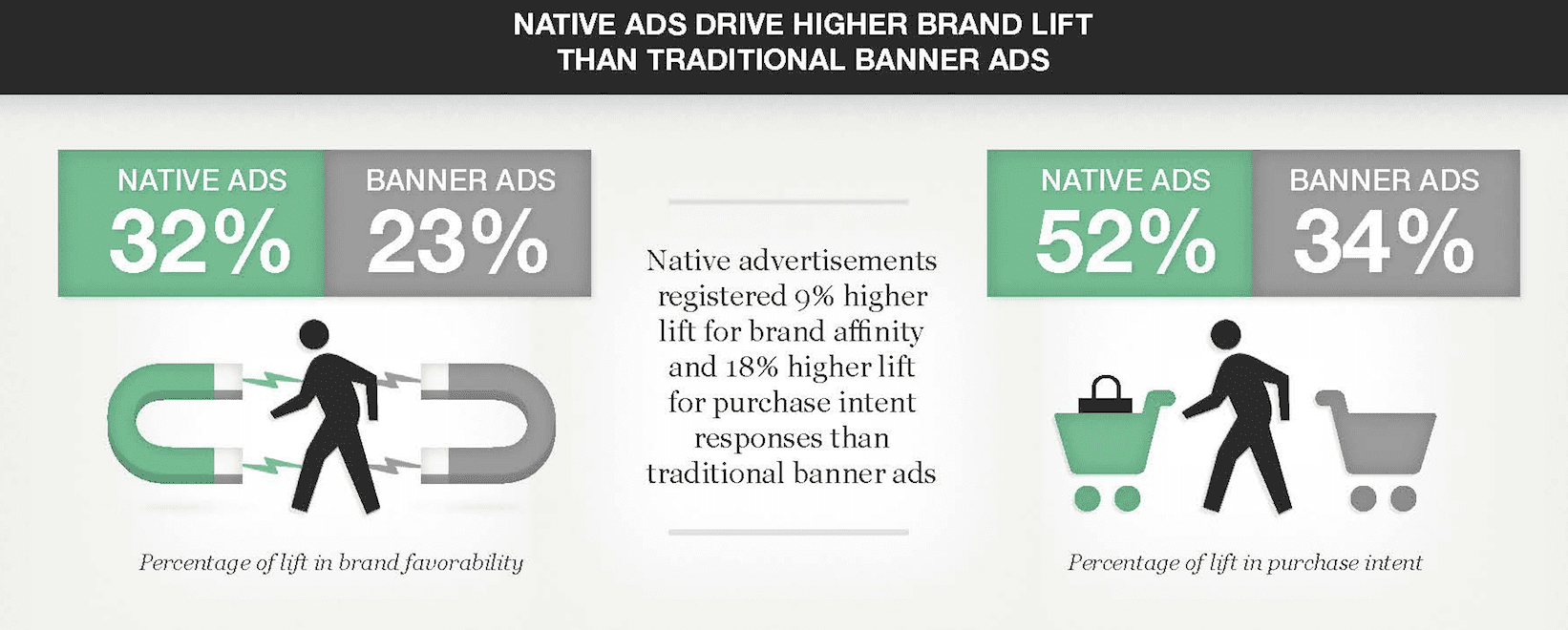
Native advertising performance
Research from IPG and Sharethrough claims native ads earn a 9% lift for brand affinity, and an 18% lift for purchase intent as compared to display banners.
Additional key findings from the study include:
- Consumers looked at native ads 53% more frequently than display ads
- 25% more consumers were measured to look at in-feed native ad placements (the most common editorial native ad format) than display ad units
- 32% of respondents said the native ad “is an ad I would share with a friend of family member” versus just 19% for display ads
Native advertising growth
According to eMarketer, spending on native digital display ads makes up more than half of all digital display ad spending in the US in 2017.
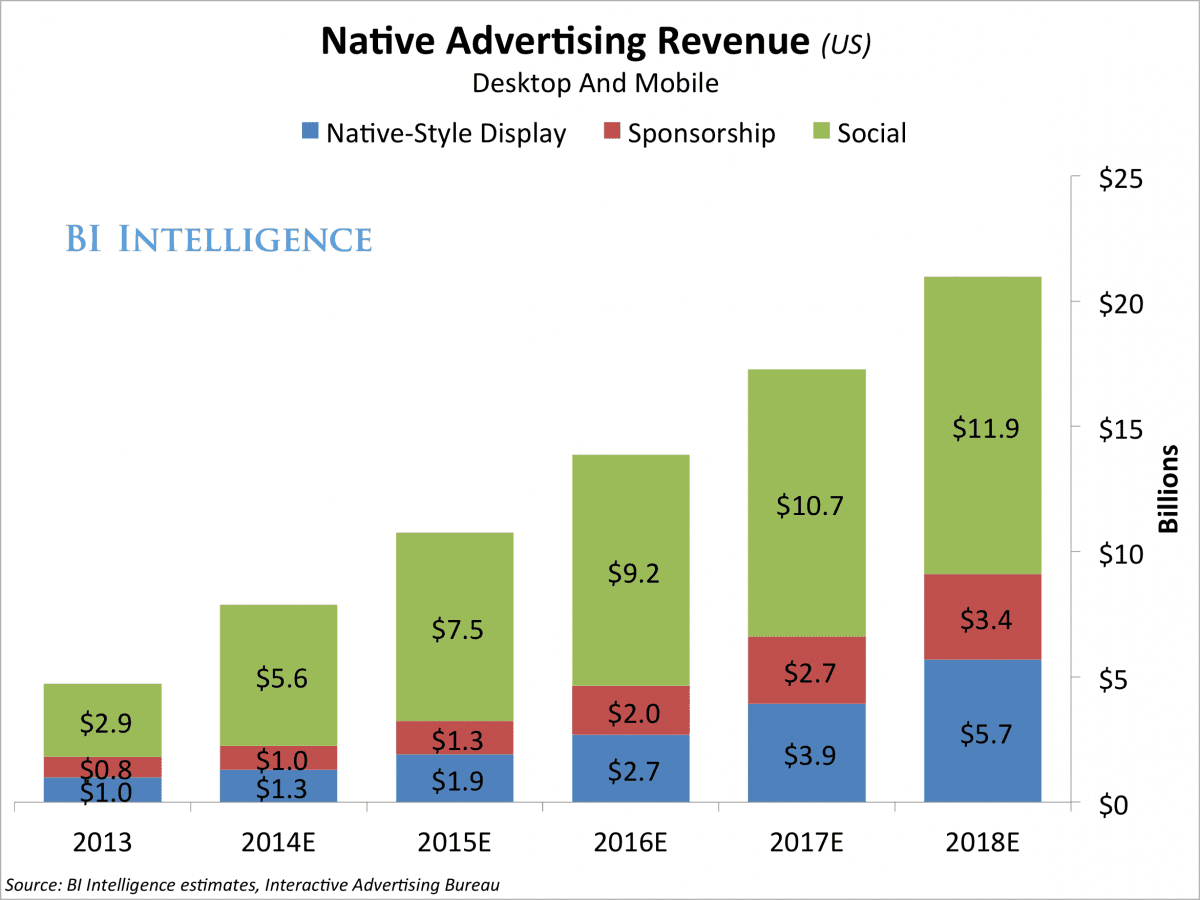
According to BI Intelligence and Interactive Advertising Bureau, investment in the three main forces in native advertising rises significantly each year.
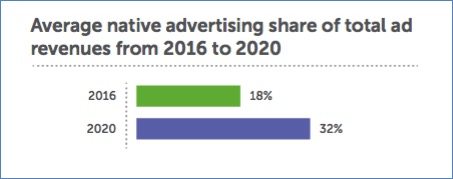
A report from the Native Advertising Institute claims that native advertising generated 18% of overall advertising revenues in 2016, and publishers expect that number to rise to 32% by 2020.
Native advertising brings light into the darkness
Before I get busted for plagiarism, I want to admit I loved the subheadline I found in a post on 1and1.com and had to include it. And I shall mirror some points they make to wrap this one up…
Banner blindness is a serious challenge. Ad blockers pose a serious challenge. The ad industry must recognize banner blindness and move on to new ad formats.
Native advertising has proven to help publishers sell ad space, and helped the advertisers reach targeted audiences.
A version of this post was first published on the Taboola blog.